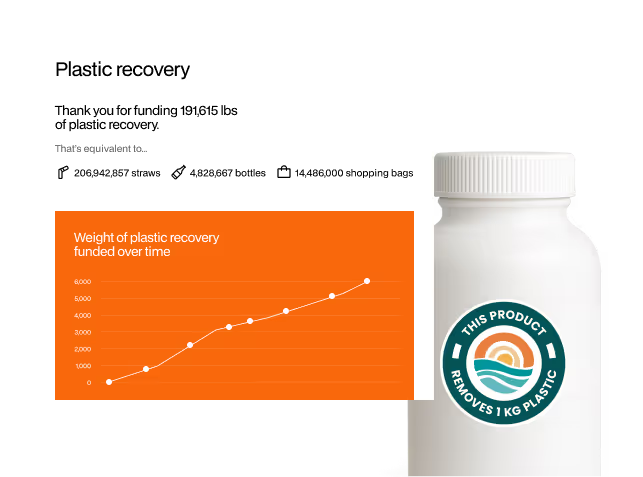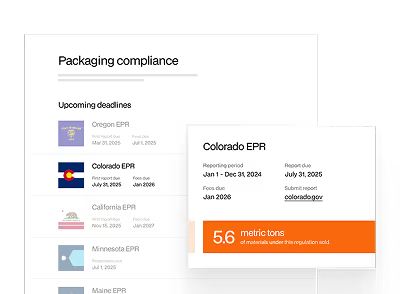Plastic packaging is entering a new regulatory era. Retailers are at the center of this shift — managing packaging across thousands of SKUs, navigating fragmented policies, and facing rising costs tied to virgin plastic.
In both the United States and the European Union, regulators are moving aggressively to make companies responsible for the packaging they put on the market. For retailers, this means compliance can no longer be treated as a back-office function — it will directly affect cost structures, supply chain decisions, and brand competitiveness.
This article explains what’s changing, why it matters, and how retailers can prepare for regulations that will define the next decade of commerce.
Why Plastic Rules Are Changing So Quickly
- Environmental urgency: According to the OECD, global plastic waste could triple by 2060 if current trends continue, with packaging as the single largest driver.
- Consumer demand: Surveys show that 72% of shoppers buy more eco-friendly products than they did five years ago, and 75% of millennials consider sustainability when making purchases (McKinsey + NielsenIQ).
- Policy alignment: Governments are shifting costs from taxpayers to producers. Extended Producer Responsibility (EPR) schemes, recycled content mandates, and bans on single-use plastics are becoming the global standard.
For retailers, this means plastic strategy is no longer optional. It is a matter of license to operate.
Retail Packaging 101 – What’s Actually Covered
Regulations typically cover the full spectrum of packaging used in retail:
- Primary packaging: wrappers, trays, bottles, and pouches.
- Secondary packaging: boxes, cartons, and multi-SKU packaging
- Tertiary/transport packaging: pallets, shrink wrap, protective films.
- Shopping bags and point-of-sale plastics.
Retailers must track all of these streams, including differences between necessary packaging (e.g., food safety) and avoidable packaging (e.g., excessive clamshells). This distinction matters because avoidable packaging is increasingly subject to bans or higher fees.
Spotlight on the United States – A Patchwork of State Laws
The U.S. has no federal packaging law, leaving states to set their own rules. As of 2025:
- Seven states (including California, Oregon, Maine, and Colorado) have passed EPR laws for packaging, covering ~25% of the U.S. population.
- California has gone further, requiring 65% of plastic packaging to be recyclable or compostable by 2032 and mandating recycled content in beverage containers.
For multi-state retailers, this creates a compliance patchwork. Packaging that is legal in Texas may be restricted or fee-intensive in California. Without robust data management, compliance risk escalates.
The EU’s model is harmonized across member states, which provides predictability, though the requirements are stringent.
The European Union has opted for harmonized regulation across its 27 member states:
- Packaging and Packaging Waste Regulation (PPWR): Requires all packaging to be recyclable or reusable by 2030.
- Single-Use Plastics Directive (SUPD): Bans items like cutlery, plates, straws, and polystyrene containers.
- Reusable transport packaging: 40% of transport packaging must be reusable by 2030, increasing to 70% by 2040.
- Minimum recycled content mandates: 30% PCR in PET bottles by 2030, with likely extensions to other polymers.
- Extended reporting: Retailers must disclose packaging material use, recyclability, and end-of-life outcomes.
The EU’s model is predictable but strict. For global retailers, compliance in Europe often sets the gold standard that influences other regions.
What This Means for Retail Operations
Emerging rules will have material impacts on retailers:
- Purchasing: Shifting toward suppliers who can guarantee recyclable or PCR content packaging.
- Design: Rethinking private-label packaging to reduce avoidable plastics and improve recyclability.
- Supplier relationships: Collaborating on packaging innovation, shared compliance costs, and recovery programs.
- Cost structures: Factoring EPR fees into product pricing, especially for virgin or hard-to-recycle plastics.
- Data systems: Building infrastructure to track packaging by material type, weight, and end-of-life outcomes across thousands of SKUs.
How Retailers Can Get Ahead of Compliance
Practical steps retailers can take now:
- Map your packaging footprint across all SKUs — by material type, weight, and geography.
- Engage suppliers on recyclable, reusable, and PCR options.
- Invest in data systems for EPR reporting. rePurpose Global’s platform is extremely effective in translating packaging data into regulatory reports, forecasting fees, and recommending packaging changes.
- Pilot redesigns in high-volume categories (bags, clamshells, pouches) to avoid future bans and reduce EPR exposure.
FAQs on Retail Plastic Regulations
Can retail stores still use plastic bags?
It depends on the market. The EU bans many single-use bags, while in the U.S., more than 10 states (including California and New York) have enacted bag bans or fees. Retailers must track state- and country-specific rules.
What’s considered retail packaging vs. transport packaging?
Retail packaging includes consumer-facing formats (wrappers, bottles, bags), while transport packaging refers to pallets, shrink wrap, and protective films used in logistics. Regulations often treat them differently.
What is the most common plastic in retail packaging?
Globally, polyethylene (PE) and polypropylene (PP) dominate flexible retail packaging. PET is most common in bottles. These polymers are increasingly subject to PCR content mandates.
How do these rules affect small retailers compared to large chains?
Large chains typically have compliance teams and supplier leverage. Small retailers face proportionally higher costs and administrative burdens but can mitigate this by leveraging shared compliance platforms like rePurpose’s.
How can retailers prepare for EPR fees?
By mapping packaging portfolios, substituting high-fee materials (e.g., multilayer films), and using tools like rePurpose Global’s AI-driven platform to model exposure and identify redesign opportunities.
From Obligation to Opportunity
Emerging packaging rules are not temporary trends. They are structural shifts that will define how retail operates in the coming decade.
Retailers who treat compliance as a strategic investment — not just an obligation — will benefit from lower long-term costs, stronger consumer trust, and access to recycled feedstock.
By combining packaging redesign, data-driven compliance, and verified plastic recovery, retailers can stay ahead of regulation while contributing to the systems change needed to solve plastic pollution.

.jpg)
.png)
.avif)

.jpg)






